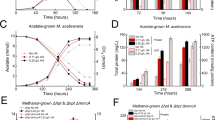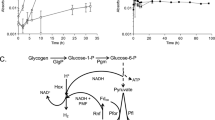Abstract
Respiratory processes in bacteria are remarkable because of their ability to use a variety of compounds, including insoluble minerals, as terminal electron acceptors1. Although much is known about microbial electron transport to soluble electron acceptors, little is understood about electron transport to insoluble compounds such as ferric oxides2,3. In anaerobic environments, humic substances can serve as electron acceptors and also as electron shuttles to ferric oxides4,5,6. To explore this process, we identified mutants in Shewanella putrefaciens that are unable to respire on humic substances. Here we show that these mutants contain disruptions in a gene that is involved in the biosynthesis of menaquinone. During growth, the wild type releases a menaquinone-related redox-active small molecule into the medium that complements the mutants. This finding raises the possibility that electron transfer to a variety of oxidants, including poorly soluble minerals, may be mediated by microbially excreted quinones that have yet to be identified.
This is a preview of subscription content, access via your institution
Access options
Subscribe to this journal
Receive 51 print issues and online access
$199.00 per year
only $3.90 per issue
Buy this article
- Purchase on Springer Link
- Instant access to full article PDF
Prices may be subject to local taxes which are calculated during checkout



Similar content being viewed by others
References
Brock,T. D. & Madigan,M. T. Biology of Microorganisms 6th edn (Prentice Hall, New Jersey, 1991).
Gennis,R. B. & Stewart,V. in Escherichia coli and Salmonella: Cellular and Molecular Biology vol 1 (ed. Neidhardt, F. C.) 217–261 (ASM, Washington DC, 1996).
Lovley,D. R. Dissimilatory Fe(III) and Mn(IV) reduction. Microbiol. Rev. 55, 259–287 (1991).
Lovley,D. R., Coates,J. D., Blunt-Harris, E. L., Phillips,E. J. P. & Woodward,J. C. Humic substances as electron acceptors for microbial respiration. Nature 382, 445–448 (1996).
Coates,J. D. et al. Recovery of humic-reducing bacteria from a diversity of environments. Appl. Environ. Microbiol. 64, 1504– 1509 (1998).
Benz,M., Schink,B. & Brune,A. Humic acid reduction by Propionibacterium freudenreichii and other fermenting bacteria. Appl. Environ. Microbiol. 64, 4507–4512 (1998).
Caccavo,F. Jr. et al. Role of hydrophobicity in adhesion of the dissimilatory Fe (III)-reducing bacterium Shewanella alga to amorphous Fe (III) oxide. Appl. Environ. Microbiol. 63, 3837– 3843.
Arnold,R., DiChristina, T. J. & Hoffmann, M. R. Reductive dissolution of Fe (III) oxides by Pseudomonas sp. 200. Biotechnol. Bioeng. 32, 1081 –1096 (1988).
Gaspard,S., Vazquez,F. & Holliger, C. Localization and solubilization of the iron(III) reductase of Geobacter sulfurreducens. J. Bacteriol. 64 , 3188–3194.
Beliaev,A. S. & Saffarini,D. A. Shewanella putrefaciens mtrB encodes and outer membrane protein required for Fe(III) and Mn(IV) reduction. J. Bacteriol. 180, 6292– 6297 (1988).
Myers,C. R. & Myers,J. M. Localization of cytochromes to the outer membrane of anaerobically grown Shewanella putrefaciens MR-1. J. Bacteriol. 174, 3429– 3438 (1992).
Seeliger,S., Cord-Ruwisch,R. & Schink, B. A periplasmic and extracellular c-type cytochrome of Geobacter sulfurreducens acts as a ferric iron reductase and as an electron carrier to other acceptors or to partner bacteria. J. Bacteriol. 180, 3686–3691 ( 1998).
Lloyd,J. R., Blunt-Harris, E. L. & Lovley, D. R. The periplasmic 9.6 kDa c-type cytochrome is not an electron shuttle to Fe[III]. J. Bacteriol. 181, 7647–7649 (1999).
Scott,D. T., McKnight,D. M, Blunt-Harris, E. L., Kolesar,S. E. & Lovley,D. R. Quinone moieties act as electron acceptors in the reduction of humic substances by humics-reducing microorganisms. Environ. Sci. Technol. 32, 2984– 2989 (1998).
Myers,C. R. & Nealson,K. H. Bacterial manganese reduction and growth with manganese oxide as the sole electron acceptor. Science 240, 1319–1320 ( 1988).
Tratnyek,P. G. & Macalady,D. L. Abiotic reduction of nitro aromatic pesticides in anaerobic laboratory systems. J. Agri. Food Chem. 37, 248–254 (1989).
Meganathan,R. in Escherichia coli and Salmonella: Cellular and Molecular Biology vol. 1 (ed. Neidhardt, F. C.) 642–656 (ASM, Washington DC, 1996).
Myers,C. R. & Myers,J. M. Role of menaquinone in the reduction of fumarate, nitrate, iron(III) and manganese(IV) by Shewanella putrefaciens MR-1. FEMS Microbiol. Lett. 114, 215 –222 (1993).
Collins,M. D. Analysis of isoprenoid quinones. Methods Microbiol. 18, 329–366 (1985).
Alexeyev,M. F. & Shokolenko,I. N. Mini-Tn 10 transposon derivatives for insertion mutagenesis and gene delivery into the chromosome of Gram-negative bacteria. Gene 160, 59–62 (1995).
Myers,C. R. & Nealson,K. H. Respiration-linked proton translocation coupled to anaerobic reduction of manganese (IV) and iron (III) in Shewanella putrefaciens MR-1. J. Bacteriol. 172, 6232–6238 (1990).
O'Toole,G. A. et al. Genetic approaches to the study of biofilms. Methods Enzymol. 310, 91–109 ( 1999).
Altschul,S. F. et al. Gapped BLAST and PSI-BLAST: a new generation of protein database search programs. Nucleic Acids Res. 25, 3389–3402 (1997).
Stookey,L. L. Ferrozine: a new spectrophotometric reagent for iron. Anal. Chem. 42, 779–781 ( 1970).
Lovley,D. R. & Phillips,E. J. Novel mode of microbial energy metabolism: organic carbon oxidation coupled to dissimilatory reduction of iron and manganese. Appl. Environ. Microbiol. 54, 1472–480 (1988).
Acknowledgements
We thank C. Myers for providing S. putrefaciens strain MR-1 and members of the Kolter lab, P. Belshaw, F. Morel, B. Schink and D. Lovley for advice and encouragment. Preliminary sequence data was obtained from The Institute for Genomic Research website (http://www.tigr.org). Sequencing of S. putrefaciens was accomplished with support from the Department of Energy. This research was supported by the Office of Naval Research, NIH and a postdoctoral fellowship to D.K.N. by the Cancer Research Fund of the Damon Runyon Walter Winchell Foundation.
Author information
Authors and Affiliations
Corresponding author
Rights and permissions
About this article
Cite this article
Newman, D., Kolter, R. A role for excreted quinones in extracellular electron transfer. Nature 405, 94–97 (2000). https://doi.org/10.1038/35011098
Received:
Accepted:
Issue Date:
DOI: https://doi.org/10.1038/35011098
This article is cited by
-
Unlocking the Anticancer Potential of Frankincense Essential Oils (FEOs) Through Nanotechnology: A Review
Molecular Biotechnology (2023)
-
The contribution of living organisms to rock weathering in the critical zone
npj Materials Degradation (2022)
-
Sulfate differentially stimulates but is not respired by diverse anaerobic methanotrophic archaea
The ISME Journal (2022)
-
Inactivation of Escherichia coli enhanced by anaerobic microbial iron reduction
Environmental Science and Pollution Research (2021)
-
Fungal quinones: diversity, producers, and applications of quinones from Aspergillus, Penicillium, Talaromyces, Fusarium, and Arthrinium
Applied Microbiology and Biotechnology (2021)
Comments
By submitting a comment you agree to abide by our Terms and Community Guidelines. If you find something abusive or that does not comply with our terms or guidelines please flag it as inappropriate.



